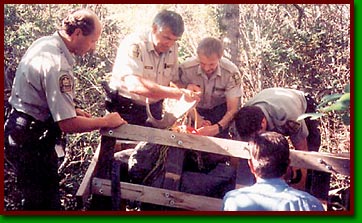![[Game Warden Archives]](photo/logo2.gif) by S.W.H. Webb
Successful and effective law enforcement goes virtually unnoticed and unrecorded, but a moose in Cedarbrae, a bear in Eagleridge or a cougar in Fish Creek Park gets immediate attention and extensive coverage. Naturally, everyone wants the animal captured and released to the wild (if such a place still exists) with minimal discomfort. To destroy an animal of any species, regardless of potential threat, brings immediate and severe public condemnation. That is reality for the urban officer.
If, when assessing the situation, the officer believes capture without injury or loss of life is possible, one option is immobilization drugs. The consequence for error resulting in injury or death poses serious ramifications to both the public and officers. Despite this, immobilization is attempted in almost every instance because of the inevitable backlash of public opinion should a decision be made to destroy the animal in the interest of public safety. In most cases, injection is administered by way of a dart fired from a specially adapted firearm and may or may not prove effective in immobilizing the animal. Wildlife officers are limited in the type of drugs available for use in this manner, primarily because of the possibility of the dart missing the target and being lost. Again, the consequences of this occurring in an urban setting are obvious. The effectiveness of the drug depends on a number of factors including the quality of the chemical, the condition of the animal, its individual susceptibility to the drug and whether or not it was chased or harassed prior to injection. Species, size and condition of the animal determine dosage. If the first injection proves ineffective, a second and sometimes a third may be necessary. All the while the animal suffers injury from each dart and is not under control for periods up to 45 minutes or more while the drug takes effect. This extends the window of opportunity for injury or damage for which the officer will, in all likelihood, be held responsible. If and when the drug does take effect, a new threat to the life of the animal occurs, particularly if the animal is a member of the deer family. The drug available is a mixture of Ketamine and Rompin, the combination of which affects the ability of muscles to respond while at the same time tranquilizing the animal. If the animal lies on its side for any length of time or is moved, relaxed sphincters enable liquid in the stomach to enter the lungs. The immediate result can be drowning, the long term effect may be pneumonia, either of which can be fatal. 
To counter this probability, officers in Calgary designed and built the "mighty moose mover". This is a platform constructed with removable side racks, equipped with skids and set up to accommodate a winch. This enables the officers to move the animal with minimal re-positioning and to transport the ungulate in an upright position. So far the success rate has been three moose moved, two successfully. The third died of what is known as capture myopathy, a complication that arises from the stress an animal experiences during capture, a condition over which there is no control. Capture myopathy and the problems caused by liquid in the lungs are not problems normally associated with the capture of large carnivores such as cougar and bear. They have their own set of circumstances. Their problems usually arise when they come out of the drug and find they have been "relocated" some distance from their established territory. Because these species are territorial by nature, the individual must now either run off the local dominant member of the species or be run off itself. The latter is usually the case and they find themselves running a gauntlet until they are successful or die from starvation, injuries or a landowner's bullet. In some cases they actually return to the city and the process must be repeated. S.W.H. Webb is a member of the Alberta Fish and Wildlife Officers Association in Calgary.
|
